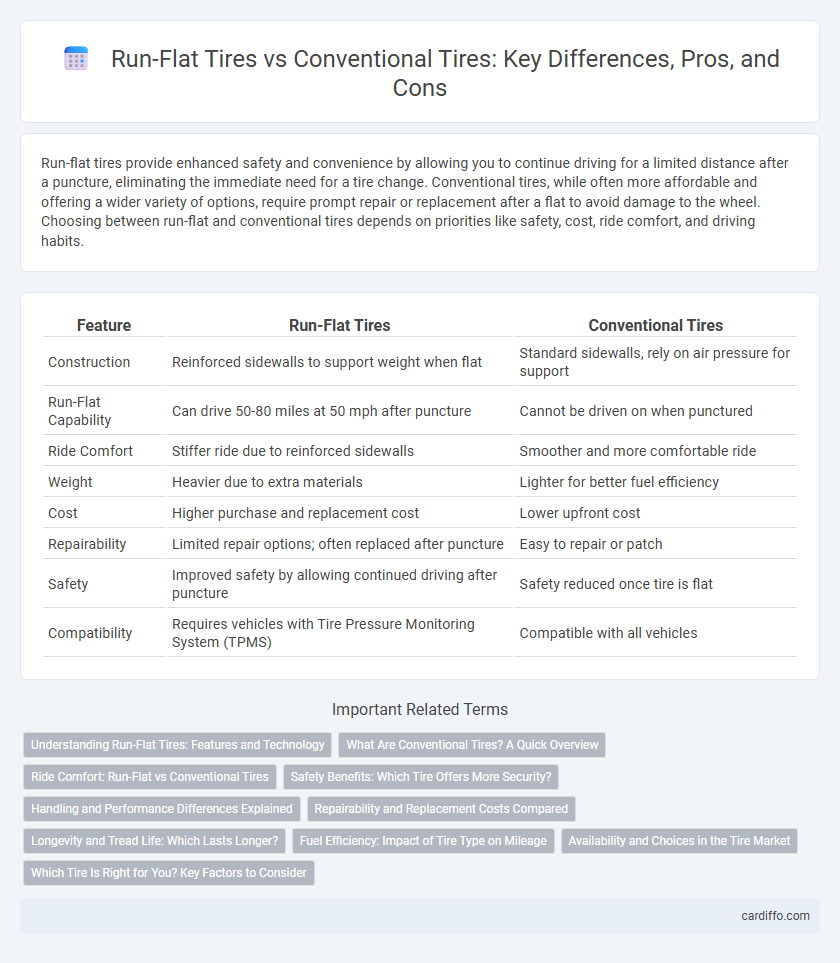Run-flat tires provide enhanced safety and convenience by allowing you to continue driving for a limited distance after a puncture, eliminating the immediate need for a tire change. Conventional tires, while often more affordable and offering a wider variety of options, require prompt repair or replacement after a flat to avoid damage to the wheel. Choosing between run-flat and conventional tires depends on priorities like safety, cost, ride comfort, and driving habits.
Table of Comparison
| Feature | Run-Flat Tires | Conventional Tires |
|---|---|---|
| Construction | Reinforced sidewalls to support weight when flat | Standard sidewalls, rely on air pressure for support |
| Run-Flat Capability | Can drive 50-80 miles at 50 mph after puncture | Cannot be driven on when punctured |
| Ride Comfort | Stiffer ride due to reinforced sidewalls | Smoother and more comfortable ride |
| Weight | Heavier due to extra materials | Lighter for better fuel efficiency |
| Cost | Higher purchase and replacement cost | Lower upfront cost |
| Repairability | Limited repair options; often replaced after puncture | Easy to repair or patch |
| Safety | Improved safety by allowing continued driving after puncture | Safety reduced once tire is flat |
| Compatibility | Requires vehicles with Tire Pressure Monitoring System (TPMS) | Compatible with all vehicles |
Understanding Run-Flat Tires: Features and Technology
Run-flat tires feature reinforced sidewalls that allow them to maintain shape and support vehicle weight despite air pressure loss, enabling continued driving for up to 50 miles at reduced speeds. This advanced technology eliminates the immediate need for roadside tire changes, enhancing safety and convenience during tire punctures. Conventional tires lack these structural reinforcements, requiring prompt repair or replacement upon air pressure loss to avoid further damage and ensure safe driving.
What Are Conventional Tires? A Quick Overview
Conventional tires rely on air pressure to support the vehicle's weight and provide a smooth ride, requiring regular maintenance to prevent flats. These tires typically offer better fuel efficiency and cost less upfront compared to run-flat options. Proper inflation and timely repairs are essential for safe performance and longevity in conventional tires.
Ride Comfort: Run-Flat vs Conventional Tires
Run-flat tires offer enhanced safety by allowing continued driving after a puncture, but they often sacrifice ride comfort due to stiffer sidewalls. Conventional tires provide a smoother and more comfortable ride because of their flexible sidewall construction, which better absorbs road vibrations and irregularities. Choosing between run-flat and conventional tires involves balancing ride comfort against emergency mobility and safety needs.
Safety Benefits: Which Tire Offers More Security?
Run-flat tires enhance safety by allowing vehicles to continue driving for up to 50 miles at reduced speeds after a puncture, reducing the risk of accidents from sudden tire failure. Conventional tires, lacking this capability, require immediate replacement or repair, increasing exposure to roadside hazards. The built-in reinforcement in run-flat tires also provides better stability during blowouts, offering superior security compared to conventional options.
Handling and Performance Differences Explained
Run-flat tires provide enhanced handling stability during a puncture, allowing drivers to maintain control at reduced speeds for up to 50 miles. Conventional tires offer superior ride comfort and responsiveness under normal conditions but lose performance rapidly once compromised. The reinforced sidewalls of run-flat tires contribute to increased stiffness, affecting cornering grip and driving dynamics compared to the more flexible construction of conventional tires.
Repairability and Replacement Costs Compared
Run-flat tires often have limited repair options due to their reinforced sidewalls, leading to higher replacement costs compared to conventional tires that can be repaired more easily after punctures. Conventional tires generally allow for patching or plugging, significantly reducing maintenance expenses over time. Repairability differences directly impact long-term ownership costs, making conventional tires more cost-effective for drivers prioritizing affordable repairs and replacements.
Longevity and Tread Life: Which Lasts Longer?
Run-flat tires typically feature reinforced sidewalls allowing them to operate safely after a puncture, but this design often results in a stiffer ride and faster tread wear compared to conventional tires. Conventional tires generally offer longer tread life due to greater flexibility and less heat buildup, contributing to enhanced longevity under normal driving conditions. Vehicle owners prioritizing durability and extended mileage usually find conventional tires more cost-effective, while run-flat technology provides safety benefits at the expense of overall tread life.
Fuel Efficiency: Impact of Tire Type on Mileage
Run-flat tires typically have stiffer sidewalls and increased weight, which can reduce fuel efficiency compared to conventional tires. Conventional tires, being lighter and more flexible, often provide better rolling resistance and improved mileage. Choosing conventional tires generally enhances overall fuel economy due to lower energy loss during driving.
Availability and Choices in the Tire Market
Run-flat tires offer limited availability and fewer size options compared to conventional tires, which dominate the market with a vast array of sizes and styles catering to diverse vehicle types. Conventional tires are more widely stocked by retailers and available from numerous manufacturers, resulting in competitive pricing and broader consumer choice. The restricted inventory and higher cost of run-flats reduce their accessibility despite technological advantages in safety and convenience.
Which Tire Is Right for You? Key Factors to Consider
Run-flat tires offer enhanced safety by allowing continued driving after a puncture, while conventional tires typically provide better ride comfort and lower cost. Key factors to consider include your driving habits, vehicle type, and willingness to compromise on tire replacement convenience versus performance. Assessing these aspects helps determine whether the durability and immediate mobility of run-flat tires or the affordability and smoother ride of conventional tires best suit your needs.
Run-Flat vs Conventional Infographic

 cardiffo.com
cardiffo.com